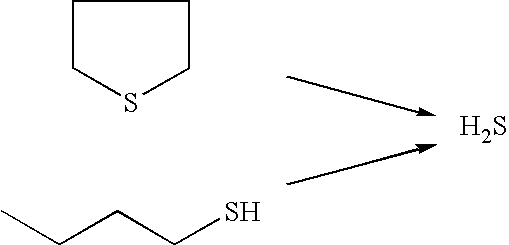Process for the production of gasolines with low sulfur contents
a technology of low sulfur content and gasoline, which is applied in the direction of organic chemistry, chemical apparatus and processes, hydrocarbon oil treatment products, etc., can solve the problems of significant drop in the octane number of the fraction, complicated procedure, and limited overall hydrodesulfurization rate at the end of the two stages
- Summary
- Abstract
- Description
- Claims
- Application Information
AI Technical Summary
Benefits of technology
Problems solved by technology
Method used
Image
Examples
example 4 (
ACCORDING TO THE INVENTION)
Hydrodesulfurization With a Scheme of Catalysts for Hydrogenation of Unsaturated Compounds Then for Decomposition of Saturated Sulfur Compounds and With Recycling of Hydrogen
The gasoline whose characteristics are described in Table 1 is subjected to hydrodesulfurization in a catalyst scheme in an isothermal tubular reactor. 25 ml of the HR306C.RTM. catalyst, marketed by the Procatalyse Company, and 50 ml of the catalyst that is obtained according to the same procedure as the one that is described in Example 2 are placed in the hydrodesulfurization reactor. The catalysts are first sulfurized by treatment for 4 hours under a pressure of 3.4 MPa at 350.degree. C., in contact with a feedstock that consists of 2% of sulfur in the form of dimethyl disulfide in n-heptane.
The operating conditions of the hydrodesulfurization are as follows: VVH=1.33 h.sup.-1 relative to the entire catalytic bed H.sub.2 / HC=400 1 / 1, P=2.7 MPa. The temperature of the catalytic zone t...
example 5 (
ACCORDING TO THE INVENTION)
Hydrodesulfurization With a Scheme of Catalysts for Hydrogenation of Unsaturated Compounds and for Decomposition of Saturated Sulfur Compounds, With Recycling of Hydrogen
The gasoline whose characteristics are described in Table 1 is subjected to hydrodesulfurization on a scheme of catalysts in an isothermal tubular reactor. 25 ml of the HR306C.RTM. catalyst, marketed by the Procatalyse Company, and 50 ml of the catalyst that is obtained according to the same procedure as the one that is described in Example 2 are placed in the hydrodesulfurization reactor. The catalysts are first sulfurized by treatment for 4 hours under a pressure of 3.4 MPa at 350.degree. C., in contact with a feedstock that consists of 2% of sulfur in the form of dimethyl disulfide in n-heptane.
The operating conditions of the hydrodesulfurization are as follows: VVH=1.33 h.sup.-1 relative to the entire catalytic bed; H.sub.2 / HC=400 1 / 1, P=2.7 MPa. The temperature of the catalytic zone ...
PUM
| Property | Measurement | Unit |
|---|---|---|
| temperature | aaaaa | aaaaa |
| temperature | aaaaa | aaaaa |
| temperature | aaaaa | aaaaa |
Abstract
Description
Claims
Application Information
 Login to View More
Login to View More - R&D
- Intellectual Property
- Life Sciences
- Materials
- Tech Scout
- Unparalleled Data Quality
- Higher Quality Content
- 60% Fewer Hallucinations
Browse by: Latest US Patents, China's latest patents, Technical Efficacy Thesaurus, Application Domain, Technology Topic, Popular Technical Reports.
© 2025 PatSnap. All rights reserved.Legal|Privacy policy|Modern Slavery Act Transparency Statement|Sitemap|About US| Contact US: help@patsnap.com


